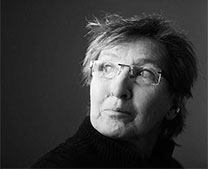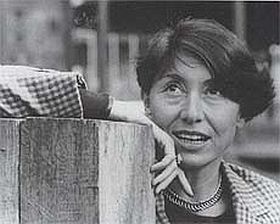


Julia Kristeva: .. films as a substitute

Kristeva analyses paintings and books but suddenly while reading an essay on Marguerite Duras, I meet this thought provoking reflection on film language:
“For such silent or precious exaggeration of speech, for its weakness tensed as if on a tightrope above suffering, films come as a substitute. Having recourse to theatrical representation, and especially to the film image, necessarily leads to an uncontrollable wealths of associations, of semantic and sentimental richness or poverty according to the wiewer. If it be true that images do not make up for verbal stylistic awkwardness, they do nevertheless plunge it into the inexpressible – the “nothing” becomes undecidable and silence inspires one to muse.
As a collective art, even when the scriptwriter manages to control it, the cinema adds something to the Spartan indications of the author (who ceaselessly protects a sickly secret at the heart of a more and more elusive plot); what it adds are the inevitably spectacular volumes and aggregates of bodies, gestures, actors’ voices, setting, lighting, producers and all those whose task is to show.
If Duras uses the screen in order to burn out its spectacular strength down to the glare of the invisible by engulfing it in elliptical words and allusive sounds, she also uses it for its excess of fascination, which compensates for verbal constriction. As the characters’ seductive power is thus increased, their invisible malady becomes less infectious on the screen because it can be performed: filmed depression appears to be an alien artifice.
We now understand why Duras’ books should not be put into the hands of oversensitive readers. Let them go see the films and the plays; they will encounter the same malady of distress but subdued, wrapped up ina dreamy charm that softens it and also makes it more feigned and made up – a convention. Her books, on the contrary bring us to the verge of madness.”
“A cette exagération silencieuse ou précieuse de la parole, à sa défaillance tendue en corde raide sur souffrance, vient suppléer le cinéma. Recourir à la représentation théâtrale, mais surtout à l’image cinématographique, conduitnécessairement à une profusion immaîtrisable d’associations, de richesses ou de pauvretés sémantiqueset sentimentales au gré du spectateur. S’il est vrai que les images ne réparentpas les maladresses stylistiques verbales, elles les noient cependant dans l’indicible : le “rien” devient indécidable et le silencefait rêver. Art collectif même si la scénariste parvient à le contrôler, le cinéma ajoute aux indications frugales de l’auteur (qui protège sans cesse un secret maladif au creux d’une intrigue de plus en plus insaisissable dans le texte) les volumes et les combinaisons, forcément spectaculaires, des corps, des gestes, des voix des acteurs, des décors, des lumières, des producteurs, de tous ceux dont le métier est de montrer. Si Duras utilise le cinéma pour user jusqu’à l’éblouissement de l’invisible sa force spectaculaire en la submergeant de mots elliptiques et de sons allusifs, elle l’utilise aussi pour son surplus de fascination qui remédie à lacontraction du verbe. en multipliant ainsi le pouvoir de séduction de ses personnages, leur maladie invisible devient à l’écran moins contagieuse à force d’êtrejouable : la dépression filmée apparaît un artifice étranger.
On comprend désormais qu’il ne faut pas donner les livres de Duras aux lecteurs et lectrices fragiles. Qu’ils aillant voir les films et les pièces, ils retrouveront cette même maladie de la douleur mais tamisée, enrobée d’un charme rêveur qui l’adoucit et la rend aussi plus factice et inventée : une convention. Les livres, au contraire, nous font côtoyer la folie.”
Litt.: Julia Kristeva: Black Sun – Depression and Melancholia, 1989. Soleil noir – dépression et mélancolie, 1987.